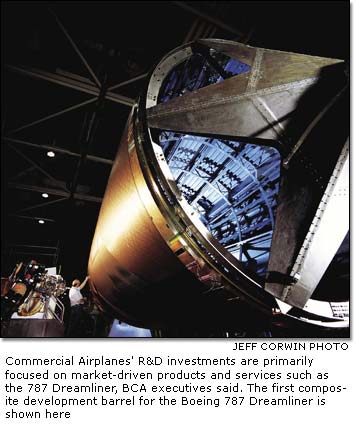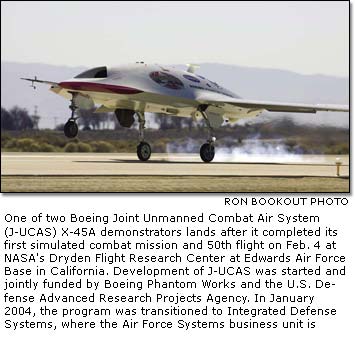Balancing act
Sound R&D strategy has Boeing poised
for competitive future BY DEBBY ARKELL

Decisions, decisions. Business leaders and employees make millions of
them every day. Among the most crucial Boeing must make are decisions
related to remaining competitive today, tomorrow and well into the future.
Corporate investment in the right technologies and processes, at the
right time, is critical to a company's success. Boeing actively plans
its research and development investments in technology in a way that will
maximize potential returns, fueling the company's top- and bottom-line
growth.
 Boeing
Chief Technology Officer Jim Jamieson said the decisions on what specific
technologies and processes Boeing will pursue are based on a balanced
combination of available company funding and other resources, and degree
of immediacy of need. Through this analysis, Boeing strives to get the
most from the money it invests in R&D—a percentage that company
leaders say strikes the proper balance between investing in the future
and delivering shareholder returns. Boeing
Chief Technology Officer Jim Jamieson said the decisions on what specific
technologies and processes Boeing will pursue are based on a balanced
combination of available company funding and other resources, and degree
of immediacy of need. Through this analysis, Boeing strives to get the
most from the money it invests in R&D—a percentage that company
leaders say strikes the proper balance between investing in the future
and delivering shareholder returns.
"Each year Boeing invests about 4 percent of the company's overall
revenue in research and development , amounting to more than $2 billion,"
Jamieson said. "This investment, along with the amount we receive
for contract R&D each year, provides Boeing with a very healthy R&D
program by industry standards."
Boeing distributes its R&D investments carefully among the business
units, Phantom Works and enterprise initiatives. The business units focus
primarily on their near-term needs for product and process development
and improvements; Boeing's centrally managed advanced R&D unit, Phantom
Works, focuses on providing systems and technologies that will benefit
products across all the business units—both in the near and far
term.
Likewise, the enterprise common processes and systems initiative is designed
to help business units and functions of the company work together more
efficiently and on a global scale.
"The big challenge in all this is to maximize our leverage with
every R&D dollar we spend," Jamieson said. "This means understanding
what our short- and long-term business objectives are, investing in technologies
and processes required to achieve them, and sharing what we learn with
others in the company."
| FLEX TRACK
Ask anyone who builds F-15s for a living and they'll tell you:
They have a lot of fasteners. Indeed, most aircraft today have a
lot of fasteners—small parts that require a lot of drilling,
which is a source of variance in manufacturing.
The great minds in Boeing's technology organizations know that
there's always room for new ideas and better ways to do things—including
how to drill holes.
In May, Integrated Defense Systems employees placed into the production
process a tool called Flex Track, a small, programmable and numerically
controlled tool that attaches to an assembly for drilling.
Employees in Commercial Airplanes Material and Process Technology
developed the initial prototype of the tool, which uses suction
cups to attach the tool to the part.
"Boeing has been pursuing the idea of a track drill since
the 1970s," said Jim Buttrick, Assembly Technology, Manufacturing
& Process Technology equipment design group, and member of the
team that invented the Flex Track. "As controls got smaller,
motors more powerful and tracks more flexible, we've had an opportunity
to launch into this technology."
A vision system built into the tool works in tandem with a computer
program to locate precisely where fasteners need to be installed.
As the tool glides over the part, the computer program—also
developed by Boeing—analyzes the images and locates the center
of fasteners to within a couple thousandths of an inch.
First introduced on the F-15 production line in St. Louis, Flex
Track will soon be used on the F/A-22 and C-17 programs.
"We've only been using it for a month or so, but we're already
seeing reduced FOD [foreign object debris] in our assemblies thanks
to the built-in vacuum," said Tony Ham, director of F-15 and
C-17 Assembly. "We're also predicting improved hole quality
and significantly improved ergonomics for our employees over time."
Boeing holds multiple patents on Flex Track technology, and the
tool is now being mass-produced and distributed by a company called
Electroimpact Inc., in Mukilteo, Wash.
|
Maximizing returns
To aid in determining how company funds are allocated for R&D, Boeing
uses a technology prioritization process to determine what will be worked
on. Bob Krieger, president of Phantom Works, said this process begins
when Commercial Airplanes and Integrated Defense Systems leaders evaluate
what technology needs they have and share this information with Phantom
Works.
"We take a look at needs that might be common to both groups,"
Krieger said. "This helps us determine what we'll focus on because,
as with any situation, there are always more needs than money, time and
resources. By working with our business unit partners, we gain new knowledge
about how to develop technologies so that they can be adapted to fit the
various product-line requirements across Boeing."
Boeing leaders in the business units—including John Tracy, IDS
vice president of Engineering, Vice President of Product Development Dan
Mooney and Vice President of Technology Development Charlie Higgins in
BCA—create a linkage between key programs and developers. That essentially
creates a discussion loop, to ensure the business unit needs are clearly
translated, understood and met by the teams working on the new technologies.
"Boeing is ultimately more efficient in its research and development
because of its focus on common technologies," said Tracy. "Money
Boeing invests in research often benefits more than one program."
In general, Boeing's research and development funds are spread out across
a variety of programs and initiatives. Some R&D activities are business-unit
specific, such as new tooling to support the 737 program or the Joint
Unmanned Combat Air System.
Others are joint-development or common programs, such as research related
to composite structures and approaches to composite manufacturing, new
metallic processes to improve alloys, or open systems architectures. And
some are more advanced technologies, such as those for hypersonic flight,
robotic maintenance satellites, and nanotechnologies—technologies
that work at the molecular or atomic level.
All Boeing research and development work falls somewhere within three
time horizons: First, leaders across the business units identify what
capabilities they need in their products to remain competitive in the
near term (one to three years in the future) and then receive a percentage
of company revenues to develop these new or derivative products. Business
units take the lead and Phantom Works provides support through its nearer-term
work in its "thrust" technologies. Today, for instance, Commercial
Airplanes and Phantom Works are working on a combined total of nearly
1,000 technology milestones in support of the 787 Dreamliner.
"BCA R&D investments are primarily focused on market-driven
products and services," Mooney said. "A new product offering
like the 787 means placing a big bet," adding that although Boeing
studies many different ideas and concepts, leaders want to be confident
that the products developed will be a commercial success for both Boeing
and its customers before placing such a bet. "BCA relies on Phantom
Works to develop concepts and technologies that will enable products beyond
the foreseeable future."
The next time horizon is focused on creating and implementing tomorrow's
technologies in next-generation products. In Phantom Works, much of this
research is performed in the advanced systems organizations where, for
example, next-generation autonomous systems are being developed for IDS.
The results of this research might be ready to be transitioned to the
businesses in three to seven years.
 "Phantom
Works is a business unit designed to be on the leading edge of technology,
with an emphasis on taking risks in developing and testing new technologies,"
said Krieger. He noted that not all technology developments are successful,
but it is better for Phantom Works to discover problems before the business
units apply the technology in their products. "Our role is to mature
these technologies so they can be transferred to the business units, where
they'll be implemented with low risk and continue the revenue-generation
cycle." "Phantom
Works is a business unit designed to be on the leading edge of technology,
with an emphasis on taking risks in developing and testing new technologies,"
said Krieger. He noted that not all technology developments are successful,
but it is better for Phantom Works to discover problems before the business
units apply the technology in their products. "Our role is to mature
these technologies so they can be transferred to the business units, where
they'll be implemented with low risk and continue the revenue-generation
cycle."
Finally, Phantom Works looks out seven to 20 years in research areas
called enabling technologies and "White Space." Enabling technologies
often don't have a connection to a product yet and are further out from
production or implementation. White Space research is focused on developing
concepts that have even more distant future potential. A personal transportation
system involving flying "cars" is just one example of a potential
business opportunity that would fill a white space between today's business
units.
Processes and people
Another part of Boeing's technology strategy focuses on such corporate
initiatives as the development and deployment of common processes and
systems.
"We are pursuing our vision of being able to design and build anywhere
around the world and around the clock, in the most efficient and effective
way possible," Jamieson said. "This means identifying and establishing
a core of common processes and systems that all of our engineering, business
and administrative personnel can use to effectively conduct business on
a global scale."
Jamieson, who leads the common processes and systems initiative for Boeing,
noted that it is largely the enterprise process councils that are helping
implement this initiative.
"Process councils in each discipline meet to make sure we're driving
the best common processes and systems across the company," he said.
"And just as important, the process councils help ensure that the
company has the right breadth, depth and mix of skills to effectively
conduct business within the processes and systems."
So, spread among the various business units, Phantom Works and corporate
initiatives, Boeing's technology investments are taking as much care of
the company's long-term needs as its near-term needs—ultimately
making Boeing one of the most satisfying places in the world to work,
Jamieson said.
"Our decision to continuously and substantially invest in technology
and to commit our best, most innovative minds to defining the future of
flight is what will keep us producing amazing things for the world—and
keep us proud of what we've accomplished."
debra.j.arkell@boeing.com
|

